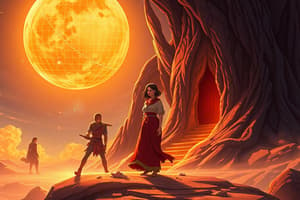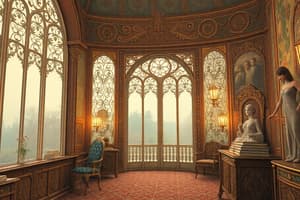Podcast
Questions and Answers
What are the primary functions of arts?
What are the primary functions of arts?
- Personal
- Social
- Physical
- All of the above (correct)
What is the origin of the word 'art'?
What is the origin of the word 'art'?
Derived from Latin word (ars = skill) and Greek word (techne = craft)
Which of the following are classifications of art subjects?
Which of the following are classifications of art subjects?
- Person
- Nature
- Event
- All of the above (correct)
Art is only a reflection of beauty.
Art is only a reflection of beauty.
What distinguishes representational art from non-representational art?
What distinguishes representational art from non-representational art?
What is subjective meaning in art?
What is subjective meaning in art?
Art serves as a tool that __________ works.
Art serves as a tool that __________ works.
List some mediums of visual art.
List some mediums of visual art.
Which of the following describes the element of color in visual arts?
Which of the following describes the element of color in visual arts?
What does the term 'harmony' mean in relation to visual arts?
What does the term 'harmony' mean in relation to visual arts?
The repetition of visual units always creates monotony.
The repetition of visual units always creates monotony.
Flashcards are hidden until you start studying
Study Notes
The Creation of Arts
- Involves the creation of ideas, materials, and forms.
The Creation of Ideas
- Artists draw from personal experiences to create various art forms including dance, visual arts, poetry, music, and theater.
The Creation of Materials
- Artists employ different mediums, also known as materials, to envisage and manifest their ideas.
The Creation of Forms
- Diverse forms are utilized by artists to represent their ideas through physical artwork.
Definition of Art
- Originates from Latin (ars = skill) and Greek (techne = craft), highlighting technical prowess.
- Represents the ultimate expression of human thoughts and emotions.
- Creativity involves reordering and combining existing materials to produce unique objects.
- Functions as a reflection of experiences, documenting human history and development.
- Art is associated with beauty and aims to provide aesthetic pleasure.
Subjects of Art
- Main subjects include persons, nature, objects, events, and scenes.
Classification of Subjects
- Representational Art: Depicts identifiable objects or symbols and conveys stories or references.
- Non-representational Art: Lacks identifiable objects or symbols, focusing instead on abstract expression.
Types of Art Techniques
- Realism: Strives to represent subjects truthfully.
- Abstraction: Simplifies subjects to their core essence.
- Distortion: Alters perspective to convey emotional truth.
Content of Subject
- Factual Meaning: Literal interpretation, including narrative elements.
- Conventional Meaning: Symbolic interpretations with connotative significance.
- Subjective Meaning: Personal perspective and interpretation of the artist.
Functions of Art
- Personal Function: Acts as a medium for artists to communicate feelings and thoughts.
- Social Function: Aims to influence collective behavior and is often displayed publicly.
- Physical Function: Serves practical purposes in architecture and community planning.
Medium of Visual Art
- Includes painting, stained glass, acrylics, tempera, fresco, drawing, watercolor, printmaking, encaustic, and mosaic.
Elements of Visual Arts
- Line: Various types convey different feelings; horizontal suggests stability, vertical indicates strength, curves imply grace, and diagonal lines express movement.
- Shape: Categorized into natural, abstract, and non-objective forms, shaping perceptions and narratives in artwork.
Color in Art
- Defined by hue categories (red, green, blue, etc.) reflecting light spectrum.
- Adds quality and mood to artwork, symbolizing ideas and emotions while enhancing pleasure through tonal harmony.
Composition Elements
- Harmony: Ensuring components of the artwork relate and complement each other.
- Contrast: Element that provides visual variety to combat monotony.
- Repetition: Creates a feeling of movement and continuity through consistent visual units.
- Balance: Refers to the proportional relationship in size, color, quantity, and position among elements in a composition.
Studying That Suits You
Use AI to generate personalized quizzes and flashcards to suit your learning preferences.




